Professional Liquid Waste Removal Melbourne: Maintaining Your Atmosphere Tidy
Professional Liquid Waste Removal Melbourne: Maintaining Your Atmosphere Tidy
Blog Article
How Fluid Garbage Disposal Functions: A Thorough Introduction of Methods and Technologies Employed

Summary of Liquid Waste Types
The intricacy of fluid waste kinds necessitates a detailed understanding of their features and effects for disposal. Fluid waste can extensively be categorized right into a number of kinds, including industrial, local, farming, and contaminated materials. Each group shows distinct residential properties, requiring particular monitoring approaches to mitigate ecological and health and wellness risks.
Industrial liquid waste stems from manufacturing procedures and commonly has an array of impurities, such as heavy steels, solvents, and natural substances. Municipal fluid waste, primarily comprising wastewater from homes and commercial facilities, consists of raw material, nutrients, and pathogens (industrial wastewater treatment). Agricultural liquid waste, consisting of runoff from farms, might include fertilizers, chemicals, and animal waste, positioning dangers to water high quality and environments
Harmful liquid waste is identified by its toxicity, reactivity, or prospective to cause injury. This category consists of materials like acids, bases, and specific chemicals that necessitate rigid handling and disposal protocols. Recognizing these diverse fluid waste types is crucial for creating effective disposal techniques and ensuring conformity with environmental guidelines. Proper classification and characterization are essential for carrying out suitable therapy strategies and reducing the negative effect on public wellness and the atmosphere.
Physical Treatment Techniques
Screening is the initial action, where larger fragments and particles are eliminated from the liquid waste making use of displays or grates. In sedimentation storage tanks, heavier particles resolve at the base, forming a sludge layer, while the made clear fluid can be further treated.
Filtering is another essential approach that includes passing the fluid via permeable materials, such as sand or membrane layers, to catch smaller bits. This action improves the high quality of the liquid, making it ideal for succeeding therapy processes.

Chemical Therapy Techniques
Chemical therapy techniques are crucial for efficiently taking care of liquid waste, specifically in addressing dissolved and colloidal impurities that physical techniques might not properly get rid of. These methods make use of various chemical representatives to counteract, precipitate, or transform hazardous materials right into less unsafe types.
One common method is coagulation and flocculation, where chemicals such as alum or ferric chloride are added to promote the gathering of suspended bits. This procedure enhances sedimentation, enabling for easier removal of the resulting sludge. Furthermore, oxidation procedures, employing agents like chlorine or ozone, are utilized to damage down intricate natural compounds and microorganisms, providing the waste more secure for discharge or further treatment.
Neutralization is one more vital strategy, which adjusts the pH of acidic or alkaline waste streams to neutral levels, avoiding prospective damage to downstream systems and the environment. Moreover, progressed oxidation procedures (AOPs) make use of mixes of oxidants and ultraviolet light to degrade persistent pollutants, attaining a higher degree of treatment efficiency.
Biological Therapy Procedures
Organic therapy procedures play a crucial role in the useful reference management of liquid waste by using microbes to decay raw material and lower pollutant levels. These processes can be broadly categorized right into anaerobic and aerobic therapies, each using particular microbial communities to attain efficient Check This Out waste degradation.
Cardiovascular treatment involves making use of oxygen to help with the break down of natural materials by germs. This process is typically implemented in turned on sludge systems, where oygenation containers supply a favorable setting for microbial growth, resulting in the oxidation of organic toxins. The resultant biomass can be separated from dealt with effluent through sedimentation.
On the other hand, anaerobic therapy occurs in the absence of oxygen, relying upon different germs to damage down raw material. This approach is specifically helpful for high-strength waste, as it generates biogas, a renewable power source, while reducing sludge manufacturing. Technologies such as anaerobic digesters are frequently used in municipal and industrial applications.
Both cardio and anaerobic biological therapies not only decrease the environmental influence of fluid waste yet also promote source recuperation, making them essential elements of sustainable waste monitoring approaches. Their flexibility, performance, and effectiveness support their prevalent implementation across different industries.
Arising Technologies in Disposal
Innovative strategies to liquid waste disposal are quickly advancing, driven by advancements in technology and a raising emphasis on sustainability. Among these arising technologies, membrane bioreactors (MBRs) have obtained traction for their capability to incorporate biological treatment with membrane filtering, leading to top quality effluent that can be reused in different applications. MBRs allow smaller sized impacts and extra reliable procedures contrasted to conventional systems.
An additional encouraging growth is the usage of anaerobic digestion combined with nutrient recovery innovations, which not just deals with fluid waste however additionally creates biogas and recoups important nutrients like nitrogen and phosphorus. This my explanation double benefit enhances resource efficiency and decreases environmental influence.
In addition, progressed oxidation procedures (AOPs) are being taken on for the destruction of intricate organic toxins. These approaches make use of effective oxidants and stimulants to damage down pollutants at the molecular degree, offering a highly effective solution for tough waste streams.
Moreover, the integration of fabricated intelligence and artificial intelligence in waste management systems is optimizing operational efficiency and predictive maintenance, leading to lowered expenses and improved ecological compliance. These technologies show a significant change towards even more effective and lasting fluid garbage disposal practices.
Verdict
Finally, effective fluid waste disposal requires an extensive understanding of various methods and innovations. The integration of physical, chemical, and organic treatment approaches guarantees the reliable administration of varied waste kinds. Furthermore, the emergence of cutting-edge innovations boosts therapy efficiency and promotes sustainability in waste monitoring practices. By constantly progressing these approaches, it comes to be possible to attend to the expanding challenges related to fluid waste, ultimately adding to environmental defense and resource healing.
Fluid waste disposal is an important element of ecological management, requiring a comprehensive understanding of various techniques and innovations tailored to different waste types. Liquid waste can broadly be categorized into several types, including commercial, municipal, agricultural, and harmful waste. Agricultural fluid waste, consisting of drainage from ranches, might contain plant foods, chemicals, and pet waste, presenting dangers to water high quality and ecological communities.
Numerous physical treatment methods play an essential duty in handling fluid waste properly - industrial wastewater treatment.In final thought, efficient liquid waste disposal requires a comprehensive understanding of numerous strategies and technologies
Report this page